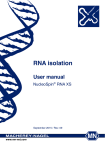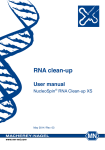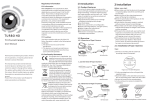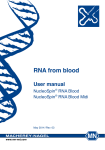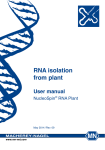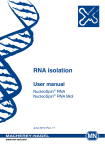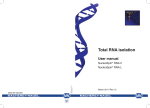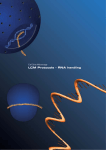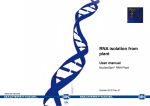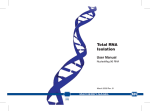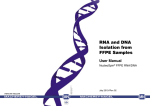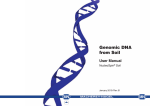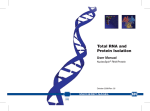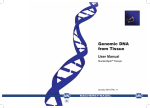Download Total RNA Isolation
Transcript
Total RNA Isolation User Manual NucleoSpin® RNA XS January 2010 / Rev. 04 MACHEREY-NAGEL Total RNA Isolation Protocol-at-a-glance (Rev. 04) XS NucleoSpin® RNA XS 1 Supply sample 2 Lyse and homogenize cells Use up to 5 x 105 cultured cells or 5 mg tissue samples 100 µl RA1 2 µl TCEP Mix 3 Add Carrier RNA 5 µl Carrier RNA working solution Mix 4 Filtrate lysate (optional) 11,000 x g 30 s 5 Adjust RNA binding condition 6 Bind RNA 100 µl 70 % ethanol Mix Load lysate 11,000 x g 30 s 7 Desalt silica membrane 100 µl MDB 11,000 x g 30 s 8 Digest DNA 25 µl DNase reaction mixture RT 15 min 9 Wash and dry silica membrane 1st wash 100 µl RA2 RT, 2 min 11,000 x g, 30 s 2nd wash 400 µl RA3 11,000 x g, 2 min 3rd wash 200 µl RA3 11,000 x g, 2 min 10 Elute highly pure RNA 10 µl RNase-free H2O 11,000 x g 30 s MACHEREY-NAGEL GmbH & Co. KG • Neumann-Neander-Str. 6-8 • D-52355 Düren • Germany Tel.: +49 (0) 24 21 969 270 • www.mn-net.com • e-mail: tech-bio@mn-net.com MN Total RNA Isolation Table of contents 1 2 Components 4 1.1 Kit contents 4 1.2 Reagents, consumables, and equipment to be supplied by user 5 1.3 About this User Manual 5 Product description 6 2.1 The basic principle 6 2.2 Kit specifications 6 2.3 Handling, preparation, and storage of starting materials 8 2.4 Elution procedures 10 2.5 Stability of isolated RNA 10 3 Storage conditions and preparation of working solutions 11 4 Safety instructions – risk and safety phrases 13 5 Protocols 15 5.1 Total RNA purification from cultured cells, laser captured cells, or microdissected cryosections with NucleoSpin® RNA XS 15 5.2 Total RNA purification from tissue with NucleoSpin RNA XS 19 ® 5.3 Clean-up and concentration of RNA with NucleoSpin RNA XS 23 5.4 Support protocol NucleoSpin® RNA XS: rDNase digestion in the eluate 26 Appendix 28 6.1 Troubleshooting 28 6.2 Ordering information 32 6.3 References 33 6.4 Product use restriction / warranty 33 ® 6 MACHEREY-NAGEL – 01 / 2010, Rev. 04 3 Total RNA Isolation 1 Components 1.1 Kit contents NucleoSpin® RNA XS 10 preps 50 preps 250 preps Cat. No. 740902.10 740902.50 740902.250 Lysis Buffer RA1 2 x 1.8 ml 25 ml 80 ml Wash Buffer RA2 2 x 1 ml 15 ml 2 x 15 ml Wash Buffer RA3 (Concentrate)* 2 ml 7 ml 2 x 20 ml Membrane Desalting Buffer MDB 1.8 ml 10 ml 50 ml Reaction Buffer for rDNase 0.5 ml 3 ml 20 ml rDNase, RNase-free (lyphilized)* 1 vial (size A) 1 vial (size C) 2 vials (size D) Carrier RNA* 300 µg 300 µg 300 µg Reducing Agent TCEP* 14 mg 3 x 14 mg 2 x 107 mg 5 ml 15 ml 25 ml NucleoSpin® Filters (violet rings) 10 50 250 NucleoSpin® RNA XS Columns (light blue rings - plus Collection Tubes) 10 50 250 Collection Tubes (2 ml) 30 150 750 Collection Tubes (1.5 ml) 10 50 250 User Manual 1 1 1 RNase-free H2O * For preparation of working solutions and storage conditions see section 3. 4 MACHEREY-NAGEL – 01 / 2010, Rev. 04 Total RNA Isolation 1.2 Reagents, consumables, and equipment to be supplied by user Reagents • 96 – 100 % ethanol (to prepare Wash Buffer RA3 and for the clean-up procedure, section 5.3) • 70 % ethanol (to adjust RNA binding condition) Consumables • 1.5 ml microcentrifuge tubes • Sterile RNase-free tips Equipment • Manual pipettors • Centrifuge for microcentrifuge tubes • Vortex mixer • Personal protection equipment (lab coat, gloves, goggles) 1.3 About this User Manual It is strongly recommended reading the detailed protocol sections of this User Manual if the NucleoSpin® RNA XS kit is used for the first time. Experienced users, however, may refer to the Protocol-at-a-glance instead. The Protocol-at-a-glance is designed to be used only as a supplemental tool for quick referencing while performing the purification procedure. All technical literature is available on the internet at www.mn-net.com. MACHEREY-NAGEL – 01 / 2010, Rev. 04 5 Total RNA Isolation 2 Product description 2.1 The basic principle One of the most important aspects isolating RNA is to prevent degradation of the RNA during the isolation procedure. With the NucleoSpin® RNA methods, cells are lysed by incubation in a solution containing large amounts of chaotropic ions. This lysis buffer immediately inactivates RNases – which are present in virtually all biological materials – and creates appropriate binding conditions which favor adsorption of RNA to the silica membrane. Contaminating DNA, which is also bound to the silica membrane, is removed by an rDNase solution which is directly applied onto the silica membrane during the preparation (RNase-free rDNase is supplied with the kit). Simple washing steps with two different buffers remove salts, metabolites and macromolecular cellular components. Pure RNA is finally eluted under low ionic strength conditions with RNasefree H2O (supplied). The RNA preparation using NucleoSpin® RNA kits can be performed at room temperature. The eluate, however, should be treated with care because RNA is very sensitive to trace contaminations of RNases, often found on general lab ware, fingerprints and dust. To ensure RNA stability, keep RNA frozen at - 20 °C for short-term or - 70 °C for long-term storage. 2.2 6 Kit specifications • The NucleoSpin® RNA XS kit is recommended for the isolation of total RNA from very small samples. Typical sample material comprises small amounts of cells (up to 5 x 105) and tissue (up to 5 mg) such as pellets of cultured cells, laser-captured cells, microdissected cryosections, biopsy samples, fine needle aspirates, and flow cytometer sorted cells (Table 1, page 7). • The innovative column design with a funnel shaped thrust ring and a small silica membrane area allows elution of RNA in as little as 5 – 30 µl. Thus, highly concentrated RNA is eluted, ready for common downstream applications (e.g., RT-PCR). • The RNA yield strongly depends on the sample type, quality and amount (see Table 2, page 8 for details). • High quality RNA (RNA Integrity Number (RIN) > 9 according to Agilent 2100 Bioanalyzer assays) can be obtained from small samples (e.g., 103 cells, 0.1 mg tissue) as well as from larger samples (105 cells, 5 mg tissue). rRNA ratios (28S / 18S) of 1.8 – 2.0 can be obtained. Since RNA quality always depends on the sample quality, see section 6.3 for further aspects. • The NucleoSpin® RNA XS kit allows purification of RNA with an A260/A280 ratio generally exceeding 1.9 (measured in TE buffer pH 7.5). Due to the high RNA purity large amounts of eluates can be used as template in RT-PCR without inhibition (e.g., 8 µl of 10 µl eluates as template in a 20 µl qRT-PCR setup generMACHEREY-NAGEL – 01 / 2010, Rev. 04 Total RNA Isolation ating stronger signal compared to reactions with less template in a LightCycler PCR with the Sigma SYBR Green Quantitative RT-PCR Kit). • The preparation time is approximately 45 min for 12 samples. • As Reducing Agent TCEP (Tris(2-carboxyethyl)phosphine) is supplied in the kit. TCEP is odorless, more stable, more specific for disulfide-bonds, and less toxic than other commonly used reducing agents. • Carrier RNA (poly(-A) RNA: poly(A) potassium salt, prepared from ADP with polynucleotide phosphorylase) is included for optimal performance with smallest samples. It is recommended adding Carrier RNA to the sample lysate (20 ng per sample). Such small amounts typically do not interfere with subsequent RT-PCR, even in oligo-dT primed reverse transcriptions. The small amount of Carrier RNA transfered into a reverse transcription reaction is commonly not significantly influencing the outcome of the reaction, due to the large excess of oligo-dT primer. The benefit of adding Carrier RNA to the sample lysate depends on sample type, amount and kind of downstream RNA analysis. If subsequent to total RNA isolation a poly-A RNA isolation is performed, adding Carrier RNA should be omitted. Other types of carrier RNA may be used in such cases, for example bacterial ribosomal RNA. • rDNase is supplied in the kit. DNA contaminations are removed by on-column digestion with rDNase. For most demanding applications (e.g., expression analysis of plasmid transfected cells, plastidial or mitochondrial genes) a subsequent digestion with rDNase in the eluate is possible. Table 1: Kit specifications at a glance NucleoSpin® RNA XS Parameter Sample material Typical yield Up to 5 x 105 cells Up to 5 mg tissue See table 2 for examples Elution volume 5 – 30 µl Binding capacity 90 µg Maximal loading volume 600 µl Preparation time Format ~ 45 min /12 preps XS spin column MACHEREY-NAGEL – 01 / 2010, Rev. 04 7 Total RNA Isolation Table 2: Overview on average yields of total RNA isolation using NucleoSpin® RNA XS 2.3 Sample Average yield 105 HeLa cells 1000 – 1500 ng 104 HeLa cells 100 – 150 ng 103 HeLa cells 10 – 15 ng 102 HeLa cells 0.1 – 1.5 ng 5 mg mouse kidney 5 – 8 µg 1 mg mouse kidney 2 µg Handling, preparation, and storage of starting materials RNA is not protected against digestion until the sample material is flash frozen or disrupted in the presence of RNase inhibiting or denaturing agents. Therefore it is important that samples are flash frozen in liquid N2 immediately and stored at - 70 °C, or processed as soon as possible. Samples can be stored in Lysis Buffer RA1* (+ TECP) after disruption at - 70 °C for up to one year, at + 4 °C for up to 24 hours or up to several hours at room temperature. Frozen samples are stable up to 6 months. Frozen samples in Buffer RA1* (+ TCEP) should be thawed slowly before starting with the isolation of total RNA. Wear gloves at all times during the preparation. Change gloves frequently. Cultured animal cells are collected by centrifugation and directly lysed by adding Buffer RA1 according to step 2 of the standard protocol (see section 5). Cell lysis of adherent growing cells in a culture dish Completely aspirate cell-culture medium, and continue immediately with the addition of Lysis Buffer RA1 to the cell-culture dish. Avoid incomplete removal of the cell-culture medium in order to allow full lysis activity of the lysis buffer. To trypsinize adherent growing cells Aspirate cell-culture medium, and add an equal amount of PBS in order to wash the cells. Aspirate PBS. Add 0.1 – 0.3 % trypsin in PBS and incubate for an appropriate time to detach the cells from the dish surface. After cell detachment, add medium, transfer cells to an appropriate tube (not supplied), and pellet by centrifugation for 5 min at 300 x g. Remove supernatant and continue with the addition of lysis buffer to the cell pellet. * Add TCEP optional before or after freezing. 8 MACHEREY-NAGEL – 01 / 2010, Rev. 04 Total RNA Isolation Cultured animal cells are often tough and should be disrupted mechanically to be available for lysis. Depending on the disruption method, the viscosity of the lysed sample has to be reduced further for optimal results. It is essential for efficient RNA preparation that all the RNA contained in the sample is released from the cells by disruption and that the viscosity of the sample is reduced by homogenization. Thawing of undisrupted animal tissue should only be done in the presence of Buffer RA1 under simultaneous mechanical disruption, for example with a rotor-stator homogenizer or a bead mill. This ensures that the RNA is not degraded by RNases before the preparation has started. Commonly used techniques for disruption of animal tissues are, for example grinding with pestle and mortar or using a syringe and needle for multiple passage of the sample through the needle. However, due to the small size of samples to be processed with NucleoSpin® RNA XS these disruption methods are often not suitable. Recommended disruption and homogenization methods The simple addition of lysis buffer and subsequent vortexing is usually sufficient to disrupt and homogenize for example up to 104 cultured cells, laser captured cells, or microdissected cryosections. Tissue can be homogenized using a rotor-stator homogenizer. The spinning rotor disrupts and simultaneously homogenizes the sample which is submerged in lysis buffer by shearing within seconds up to minutes (homogenization time depends on sample). Keep the rotor tip submerged to avoid excess foaming. Select a suitably sized homogenizer (5 – 7 mm diameter rotors can be used for homogenization in microcentrifuge tubes). Bead-milling disrupts the tissue samples, submerged in lysis buffer, by rapid agitation in the presence of beads. Suitable disruption parameters (type, size and number of beads, tube type, speed and time of agitation) have to be determined empirically for each application. MACHEREY-NAGEL – 01 / 2010, Rev. 04 9 Total RNA Isolation 2.4 Elution procedures A high RNA concentration in the elution fraction is desirable for all typical downstream applications. In particular with regard to limited volumes of reaction mixtures, high RNA concentration can be a crucial criterion. Due to a high default elution volume, standard kits often result in weakly concentrated RNA, if only small samples are processed. Such RNA often even requires a subsequent concentration to be suitable for the desired application. In contrast to standard kits, NucleoSpin® RNA XS allows an efficient elution in a very small volume resulting in highly concentrated RNA. Elution volumes in the range of 5 – 30 µl are recommended, the default volume is 10 µl. 2.5 Stability of isolated RNA Eluted RNA should immediately be put and always kept on ice during work for optimal stability! Contamination with almost omnipresent RNases (general lab ware, fingerprints, dust) may be a risk for isolated RNA. For short-term storage freeze at - 20 °C, for long-term storage freeze at - 70 °C. 10 MACHEREY-NAGEL – 01 / 2010, Rev. 04 Total RNA Isolation 3 Storage conditions and preparation of working solutions Attention: Buffers RA1, RA2, and MDB contain guanidine thiocyanate. Wear gloves and goggles! • Store lyophilized rDNase, Reducing Agent TCEP, and Carrier RNA at + 4 °C on arrival (stable up to 1 year). • All other kit components should be stored at room temperature (20 – 25 °C) and are stable up to one year. Storage at lower temperatures may cause precipitation of salts. • Check that 70 % ethanol is available as additional solution in the lab to adjust RNA binding conditions in the Buffer RA1 lysate. • Check that 96 – 100 % ethanol is available (necessary for clean-up protocol only). Before starting with any NucleoSpin® RNA XS protocol prepare the following: • rDNase: Add indicated volume (see following table or label on the rDNase vial) of RNase-free H2O to the rDNase vial and incubate for 1 min at room temperature. Gently swirl the vials to completely dissolve the rDNase. Be careful not to mix rDNase vigorously as rDNase is sensitive to mechanical agitation. Dispense into aliquots and store at - 20 °C. The frozen working solution is stable for 6 months. Do not freeze/thaw the aliquots more than three times. • Reducing Agent TCEP: Add indicated volume of RNase-free H2O to the TCEP vial and incubate for several minutes at room temperature. Mix the vial to completely dissolve the TCEP. Store dissolved TCEP at - 20 °C. • Carrier RNA: Prepare a stock solution before first time using: Dissolve the Carrier RNA in 750 µl Buffer RA1 to obtain a 400 ng / µl stock solution. Prepare a working solution before RNA extraction: Dilute 1:100 with Buffer RA1 (e.g., 1 µl Carrier RNA stock solution + 99 µl Buffer RA1) to obtain the working solution of 4 ng / µl. Add 5 µl of this working solution (20 ng) to every lysate (protocol step 3 in section 5). Store stock solution at - 20 °C; do not store working solution, prepare it freshly immediately before use. • Wash Buffer RA3: Add the indicated volume of 96 – 100 % ethanol to Wash Buffer RA3 Concentrate. Mark the label of the bottle to indicate that ethanol was added. Store Wash Buffer RA3 at room temperature (20 – 25 °C) for up to one year. MACHEREY-NAGEL – 01 / 2010, Rev. 04 11 Total RNA Isolation NucleoSpin® RNA XS 10 preps 50 preps 250 preps 740902.10 740902.50 740902.250 Wash Buffer RA3 (Concentrate) 2 ml Add 8 ml ethanol 7 ml Add 28 ml ethanol 2 x 20 ml Add 80 ml ethanol to each bottle rDNase, RNase-free (lyophilized) 1 vial (size A) Add 55 µl RNase-free H2O 1 vial (size C) Add 230 µl RNase-free H2O 2 vials (size D) Add 540 µl RNase-free H2O to each vial 300 µg 300 µg 300 µg Cat. No. Carrier RNA Add 750 µl Buffer RA1 to obtain concentrated stock solution. Dilute 1:100 with Buffer RA1 to obtain working solution. Reducing Agent TCEP 12 14 mg Add 100 µl RNase-free H2O 3 x 14 mg Add 100 µl RNase-free H2O to each vial MACHEREY-NAGEL – 01 / 2010, Rev. 04 2 x 107 mg Add 750 µl RNase-free H2O to each vial Total RNA Isolation 4 Safety instructions – risk and safety phrases The following components of the NucleoSpin® RNA XS kits contain hazardous contents. Wear gloves and goggles and follow the safety instructions given in this section. Component Hazard contents Hazard symbol Risk phrases Safety phrases rDNase, RNase-free rDNase, lyophillized Xi* May cause sensitization by inhalation and skin contact R 42/43 S 22-24 RA1 Guanidine thiocyanate Xn** Harmful by inhalation, in contact with skin, and if swallowed R 20/21/22 S 13 RA2 Guanidine thiocyanate Xn** Flammable - Harmful by inhalation, in contact with skin, and if swallowed R 1020/21/22 S 13-16 MDB Guanidine thiocyanate < 10 % + ethanol < 10 % ** Flammable R 10 S 16 TCEP Tris (2-carboxylethyl) phosphine Hydrochloride Xn* Causes burns R 34 S 26-2736/37/39 * Hazard labeling not neccessary if quantity per bottle below 25 g or ml (certificate of exemption according to 67/548/EEC Art. 25, 1999/45/EC Art. 12 and German GefStoffV § 20 (3) and TRGS 200 7.1). For further information see Material Safety Data Sheet. ** Hazard labeling not neccessary if quantity per bottle below 125 g or ml (certificate of exemption according to 67/548/EEC Art. 25, 1999/45/EC Art. 12 and German GefStoffV § 20 (3) and TRGS 200 7.1). For further information see Material Safety Data Sheet. MACHEREY-NAGEL – 01 / 2010, Rev. 04 13 Total RNA Isolation Risk phrases R 10 Flammable R 20/21/22 Harmful by inhalation, in contact with skin, and if swallowed R 34 Causes burns R 42/43 May cause sensitisation by inhalation and skin contact Safety phrases S 13 Keep away from food, drink, and animal feedstuffs S 16 Keep away from sources of ignition – No Smoking! S 22 Do not breathe dust S 24 Avoid contact with the skin S 26 In case of contact with eyes, rinse immediately with plenty of water and seek medical advice S 27 Take off immediately all contaminated clothing S 36/37/39 Wear suitable protective clothing, glovers and eye/face protection 14 MACHEREY-NAGEL – 01 / 2010, Rev. 04 NucleoSpin® RNA XS 5 Protocols 5.1 Total RNA purification from cultured cells, laser captured cells, or microdissected cryosections with NucleoSpin® RNA XS Before starting the preparation: • 1 Check if TCEP, Carrier RNA, rDNase, and Wash Buffer RA3 were prepared according to section 3. Supply sample Provide sample such as a pellet of up to 5 x 105 cultured cells, laser captured cells or microdissected cryosections in a microcentrifuge tube (not provided). For appropriate sample amounts see section 2.2. 2 Lyse and homogenize cells Add 100 µl Buffer RA1 and 2 µl TCEP to the cell sample and vortex vigorously (2 x 5 s). If multiple samples are processed, the preparation of a master-premix is recommended (e.g., 1.1 ml Buffer RA1 and 22 µl TCEP for 10 preparations). Use 102 µl of the premix. + 100 µl RA1 + 2 µl TCEP This procedure is usually sufficient to homogenize cultured cells, laser captured cells, or microdissected cryosections. For further comments on homogenization methods see section 2.3. 3 Add Carrier RNA Add 5 µl Carrier RNA working solution (20 ng) to the lysate. Mix by vortexing (2 x 5 s). Spin down briefly (approx. 1 s 1000 x g) to clear the lid. + 5 µl Carrier RNA Mix For preparation of Carrier RNA working solution see section 3. MACHEREY-NAGEL – 01 / 2010, Rev. 04 15 NucleoSpin® RNA XS 4 Filtrate lysate (optional) Place a NucleoSpin® Filter (violet ring) in a Collection Tube (2 ml; supplied), apply the mixture, and centrifuge for 30 s at 11,000 x g. This step may be skipped when working with small amounts of sample, for example less than 105 cells. 5 Adjust RNA binding condition Discard the NucleoSpin® Filter (violet ring). Add 100 µl ethanol (70 %) to the homogenized lysate and mix by pipetting up and down (5 times). Alternatively, add 100 µl ethanol (70 %) to the sample in a 1.5 ml microcentrifuge tube (not provided) and mix by vortexing (2 x 5 s). Spin down briefly (approx. 1 s 1000 x g) to clear the lid. Pipette lysate up and down two times before loading the lysate. 6 Place the column in a new Collection Tube (2 ml). The maximum loading capacity of NucleoSpin RNA XS Columns is 600 µl. Repeat the procedure if larger volumes are to be processed. ® Mix Load lysate 11,000 x g 30 s Desalt silica membrane Add 100 µl MDB (Membrane Desalting Buffer) and centrifuge at 11,000 x g for 30 s to dry the membrane. It is not necessary to use a fresh Collection Tube after this centrifugation step. Salt removal will make the following rDNase digest much more effective. If the column outlet has come into contact with the flow-through for any reason, discard the flow-through and centrifuge again for 30 s at 11,000 x g. 16 + 100 µl 70 % EtOH Bind RNA For each preparation, take one NucleoSpin® RNA XS Column (light blue ring) placed in a Collection Tube. Load the lysate to the column. Centrifuge for 30 s at 11,000 x g. 7 11,000 x g 30 s MACHEREY-NAGEL – 01 / 2010, Rev. 04 + 100 µl MDB 11,000 x g 30 s NucleoSpin® RNA XS 8 Digest DNA Prepare rDNase reaction mixture in a sterile microcentrifuge tube (not provided): for each isolation, add 3 µl reconstituted rDNase (also see section 3) to 27 µl Reaction Buffer for rDNase. Mix by flicking the tube. Apply 25 µl rDNase reaction mixture directly onto the center of the silica membrane of the column. Close the lid. Incubate at room temperature for 15 min. + 25 µl rDNase reaction mixture RT 15 min It is not necessary to use a new Collection Tube after the incubation step. 9 Wash and dry silica membrane 1st wash + 100 µl RA2 Add 100 µl Buffer RA2 to the NucleoSpin RNA XS Column. Incubate for 2 min at RT. Centrifuge for 30 s at 11,000 x g. ® Place the column into a new Collection Tube (2 ml). RT 2 min 11,000 x g 30 s Buffer RA2 will inactivate the rDNase. 2nd wash Add 400 µl Buffer RA3 to the NucleoSpin® RNA XS Column. Centrifuge for 30 s at 11,000 x g. Discard flowthrough and place the column back into the Collection Tube. + 400 µl RA3 11,000 x g 30 s 3rd wash Add 200 µl Buffer RA3 to the NucleoSpin® RNA XS Column. Centrifuge for 2 min at 11,000 x g to dry the membrane. Place the column into a nuclease-free Collection Tube (1.5 ml; supplied). If for any reason the liquid level in the Collection Tube has reached the NucleoSpin® RNA XS Column after centrifugation, discard flow-through and centrifuge again. MACHEREY-NAGEL – 01 / 2010, Rev. 04 + 200 µl RA3 11,000 x g 2 min 17 NucleoSpin® RNA XS 10 Elute highly pure RNA Elute the RNA in 10 µl H2O (RNase-free; supplied) and centrifuge at 11,000 x g for 30 s. If higher RNA concentrations or higher elution volumes are desired, elution volume may be varied in the range of 5 – 30 µl. For further details on alternative elution procedures see section 2.4. 18 MACHEREY-NAGEL – 01 / 2010, Rev. 04 + 10 µl RNase-free H 2O 11,000 x g 30 s NucleoSpin® RNA XS 5.2 Total RNA purification from tissue with NucleoSpin® RNA XS Before starting the preparation: • 1 Check if TCEP, Carrier RNA, rDNase, and Wash Buffer RA3 were prepared according to section 3. Supply sample Provide tissue sample such as a biopsy in a microcentrifuge tube (not provided). For appropriate sample amounts see section 2.2. 2 Lyse and homogenize tissue Add 200 µl Buffer RA1 and 4 µl TCEP to the tissue sample and vortex vigorously (2 x 5 s). Disruption with a rotor-stator homogenizer or with a shaker and steel balls are recommended methods for the homogenization of tissue samples. For further comments on homogenization methods see section 2.3. + 200 µl RA1 + 4 µl TCEP If multiple samples are processed, the preparation of a master-premix is recommended (e.g., 2.2 ml Buffer RA1 and 44 µl TCEP for 10 preparations). Use 204 µl of the premix. 3 Add Carrier RNA Add 5 µl Carrier RNA working solution (20 ng) to the lysate. Mix by vortexing (2 x 5 s). Spin down briefly (approx. 1 s 1000 x g) to clear the lid. + 5 µl Carrier RNA Mix For preparation of Carrier RNA working solution see section 3. MACHEREY-NAGEL – 01 / 2010, Rev. 04 19 NucleoSpin® RNA XS 4 Filtrate lysate Reduce viscosity and clear the lysate by filtration through NucleoSpin® Filter (violet ring): Place the NucleoSpin® Filter (violet ring) in a Collection Tube (2 ml; provided), apply the mixture, and centrifuge for 30 s at 11,000 x g. In case of visible pellet formation (depending on sample amount and nature), transfer supernatant without any formed pellet to a new 1.5 ml microcentrifuge tube (not included). 5 11,000 x g 30 s Adjust RNA binding condition Discard the NucleoSpin® Filter (violet ring), add 200 µl ethanol (70 %) to the homogenized lysate and mix by pipetting up and down (5 times). Alternatively, transfer flow-through into a new 1.5 ml microcentrifuge tube (not provided), add 200 µl ethanol (70 %), and mix by vortexing (2 x 5 s). Spin down briefly (approx. 1 s 1000 x g) to clear the lid. Pipette lysate up and down two times before loading the lysate. + 200 µl 70 % EtOH Mix After addition of ethanol a stringy precipitate may become visible which will not affect the RNA isolation. Be sure to disaggregate any precipitate by mixing and load all of the precipitate on the column as described in step 6. Do not centrifuge the ethanolic lysate before loading it onto the column in order to avoid pelleting the precipitate. 6 Bind RNA For each preparation, take one NucleoSpin® RNA XS Column (light blue ring) placed in a Collection Tube and load the lysate to the column. Centrifuge for 30 s at 11,000 x g. Place the column in a new Collection Tube (2 ml). The maximum loading capacity of NucleoSpin® RNA XS Columns is 600 µl. Repeat the procedure if larger volumes are to be processed. 20 MACHEREY-NAGEL – 01 / 2010, Rev. 04 Load lysate 11,000 x g 30 s NucleoSpin® RNA XS 7 Desalt silica membrane Add 100 µl MDB (Membrane Desalting Buffer) and centrifuge at 11,000 x g for 30 s to dry the membrane. It is not necessary to use a fresh Collection Tube after this centrifugation step. Salt removal will make the following rDNase digest much more effective. If the column outlet has come into contact with the flow-through for any reason, discard the flow-through and centrifuge again for 30 s at 11,000 x g. 8 + 100 µl MDB 11,000 x g 30 s Digest DNA Prepare rDNase reaction mixture in a sterile microcentrifuge tube (not provided): for each isolation, add 3 µl reconstituted rDNase (also see section 3) to 27 µl Reaction Buffer for rDNase. Mix by flicking the tube. Apply 25 µl rDNase reaction mixture directly onto the center of the silica membrane of the column. Close the lid. Incubate at room temperature for 15 min. + 25 µl rDNase reaction mixture RT 15 min It is not necessary to use a new Collection Tube after the incubation step. 9 Wash and dry silica membrane + 100 µl RA2 1st wash Add 100 µl Buffer RA2 to the NucleoSpin® RNA XS Column. Incubate for 2 min at RT. Centrifuge for 30 s at 11,000 x g. Place the column into a new Collection Tube (2 ml). RT 2 min 11,000 x g 30 s Buffer RA2 will inactivate the rDNase. 2nd wash + 400 µl RA3 Add 400 µl Buffer RA3 to the NucleoSpin RNA XS Column. Centrifuge for 30 s at 11,000 x g. Discard flowthrough and place the column back into the Collection Tube. ® MACHEREY-NAGEL – 01 / 2010, Rev. 04 11,000 x g 30 s 21 NucleoSpin® RNA XS 3rd wash Add 200 µl Buffer RA3 to the NucleoSpin® RNA XS Column. Centrifuge for 2 min at 11,000 x g to dry the membrane. Place the column into a nuclease-free Collection Tube (1.5 ml; supplied). If for any reason the liquid level in the Collection Tube has reached the NucleoSpin® RNA XS Column after centrifugation, discard flow-through and centrifuge again. + 200 µl RA3 11,000 x g 30 s 10 Elute highly pure RNA Elute the RNA in 10 µl H2O (RNase-free; supplied) and centrifuge at 11,000 x g for 30 s. If higher RNA concentrations or higher elution volumes are desired, elution volume may be varied in the range of 5 – 30 µl. For further details on alternative elution procedures see section 2.4. 22 MACHEREY-NAGEL – 01 / 2010, Rev. 04 + 10 µl RNase-free H 2O 11,000 x g 30 s NucleoSpin® RNA XS 5.3 Clean-up and concentration of RNA with NucleoSpin® RNA XS Before starting the preparation: • 1 Check if Wash Buffer RA3 were prepared according to section 3. Supply sample Provide up to 300 µl sample such as prepurified RNA (e.g., phenol purified) or RNA from reaction mixtures (e.g., labelling reactions) in a microcentrifuge tube (not provided). Sample For appropriate sample amounts see section 2.2. 2 Prepare lysis-binding buffer premix For every 100 µl of sample combine 25 µl Buffer RA1 with 75 µl ethanol (96 – 100 %) and mix. If processing multiple samples, the preparation of a master-premix (1 volume Buffer RA1 plus 3 volumes ethanol 96 – 100 %) is recommended. 3 + 25 µl RA1 + 75 µl EtOH (96 - 100 %) per 100 µl sample Mix Add Carrier RNA Not necessary! 4 Filtrate lysate Not necessary! 5 Adjust RNA binding condition Add one volume of premix to the sample (e.g., 100 µl premix to a 100 µl sample) and mix (2 x 5 s). If necessary, spin down briefly (approx. 1 s 1000 x g) to clear the lid. MACHEREY-NAGEL – 01 / 2010, Rev. 04 Add 1 vol. premix to sample Mix 23 NucleoSpin® RNA XS 6 Bind RNA For each preparation, take one NucleoSpin® RNA XS Column (light blue ring) placed in a Collection Tube and load the lysate to the column. Centrifuge for 30 s at 11,000 x g. Load lysate For samples > 300 µl, load in two steps. Place the column in a new Collection Tube (2 ml). 11,000 x g 30 s For high demanding applications, the recovery rate can be increased as follows: Centrifuge 30 s at 2,000 x g prior to centrifugation for 30 s at 11,000 x g. 7 Desalt silica membrane Not necessary! 8 Digest DNA Not necessary! 9 Wash and dry silica membrane 1st wash Add 400 µl Buffer RA3 to the NucleoSpin® RNA XS Column. Centrifuge for 30 s at 11,000 x g. Discard flowthrough and place the column back into the Collection Tube. + 400 µl RA3 11,000 x g 30 s 2nd wash Add 200 µl Buffer RA3 to the NucleoSpin® RNA XS Column. Centrifuge for 2 min at 11,000 x g to dry the membrane. Place the column into a nuclease-free Collection Tube (1.5 ml; supplied). If for any reason the liquid level in the Collection Tube has reached the NucleoSpin® RNA XS Column after centrifugation, discard flow-through and centrifuge again. 24 MACHEREY-NAGEL – 01 / 2010, Rev. 04 + 200 µl RA3 11,000 x g 2 min NucleoSpin® RNA XS 10 Elute highly pure RNA Elute the RNA in 10 µl H2O (RNase-free; supplied) and centrifuge at 11,000 x g for 30 s. If higher RNA concentrations or higher elution volumes are desired, elution volume may be varied in the range of 5 – 30 µl. For further details on alternative elution procedures see section 2.4. MACHEREY-NAGEL – 01 / 2010, Rev. 04 + 10 µl RNase-free H 2O 11,000 x g 30 s 25 NucleoSpin® RNA XS 5.4 Support protocol NucleoSpin® RNA XS: rDNase digestion in the eluate The on-column rDNase digestion in the standard protocol is very efficient and thus results in minimal residual DNA. This DNA will not be detectable in most downstream applications. However, removal of DNA to a completely undetectable level is challenging and the efficiency of an on-column DNA digestion is sometimes not sufficient for downstream applications requiring lowest residual content of DNA. A typical example for such a demanding application is an RT-PCR reaction in which the primer molecules do not differentiate between cDNA (derived from RNA) and contaminating genomic DNA. Especially, if • high copy number targets are analyzed (e.g., multi gene family, mitochondrial, plastidal or plasmid targets (from transfections)) • the target gene is of a very low expression level • the amplicon is relatively small (< 200 bp). DNA digestion in solution can efficiently destroy contaminating DNA. However, stringent RNase control and subsequent repurification of the RNA (in order to remove buffer, salts, DNase and digested DNA) are usually required. The high quality, recombinant, RNase-free DNase (rDNase) in the NucleoSpin® RNA XS kits facilitates such a digestion in solution in order to remove even traces of contaminating DNA. A Digest DNA (Reaction setup) Prepare enzyme-buffer premix: Add 1 µl rDNase to 10 µl Reaction Buffer for rDNase. Add 1 / 10 volume of enzyme-buffer premix to the eluted RNA (e.g., to 10 µl RNA add 1 µl of the premix comprising buffer and enzyme). B Incubate sample Incubate for 10 min at 37 °C. 26 MACHEREY-NAGEL – 01 / 2010, Rev. 04 NucleoSpin® RNA XS C Repurify RNA Repurify RNA with a suitable RNA cleanup procedure, for example following section 5.3, by ethanol precipitation or with the NucleoSpin® RNA Clean-up XS kit (see ordering information). Ethanol precipitation, exemplary Add 0.1 volume of 3 M sodium acetate, pH 5.2 and 2.5 volumes of 96 – 100 % ethanol to one volume of sample. Mix thoroughly. Incubate several minutes to several hours at - 20 °C or + 4 °C. Note: Choose long incubation times if the sample contains low RNA concentration. Short incubation times are sufficient if the sample contains high RNA concentration. Centrifuge for 10 min at max. speed. Wash RNA pellet with 70 % ethanol. Dry RNA pellet and resuspend RNA in RNase-free H2O. MACHEREY-NAGEL – 01 / 2010, Rev. 04 27 Total RNA Isolation 6 Appendix 6.1 Troubleshooting Problem Possible cause and suggestions RNase contamination RNA is degraded / no RNA obtained • Create an RNase free working environment. Wear gloves during all steps of the procedure. Change gloves frequently. Use of sterile, disposable polypropylene tubes is recommended. Keep tubes closed whenever possible during the preparation. Glassware should be oven-baked for at least 2 hours at 250 °C before use. Reagents not applied or restored properly Poor RNA quality or yield • Reagents not properly restored. Add the indicated volume of RNase-free H2O to rDNase vial and 96 % ethanol to Buffer RA3 Concentrate and mix. Reconstitute and store lyophilized rDNase according to instructions given in section 3. • Sample and reagents have not been mixed completely. Always vortex vigorously after each reagent has been added. • No ethanol has been added after lysis. Binding of RNA to the silica membrane is only effective in the presence of ethanol. Kit storage 28 • Reconstitute and store lyophilized rDNase according to instructions given in section 3. • Store other kit components at room temperature. Storage at low temperatures may cause salt precipitation. • Keep bottles tightly closed in order to prevent evaporation or contamination. MACHEREY-NAGEL – 01 / 2010, Rev. 04 Total RNA Isolation Problem Possible cause and suggestions Ionic strength and pH influence A260 absorption as well as ratio A260/A280. • For adsorption measurement, use 5 mM Tris pH 8.5 as diluent. Please see also: - Manchester, K L. 1995. Value of A260/A280 ratios for measurement of purity of nucleic acids. Biotechniques 19, 208 - 209. - Wilfinger, W W, Mackey, K and Chomczyski, P. 1997. Effect of pH and ionic strength on the spectrophotometric assessment of nucleic acid purity. Biotechniques 22, 474 - 481. Poor RNA quality or yield (continued) Sample material • Sample material not stored properly. Whenever possible, use fresh material. If this is not possible, flash freeze the samples in liquid N2. Samples should always be kept at - 70 °C. Never allow tissues to thaw before addition of Buffer RA1. Perform disruption of samples immediately after addition of Lysis Buffer RA1. • Insufficient disruption and/or homogenization of starting material. Ensure thorough sample disruption and use NucleoSpin® Filters for easy homogenization of disrupted starting material. Sample material Clogged NucleoSpin® Column / Poor RNA quality or yield • Too much starting material used. Overloading may lead to decreased overall yield. Reduce amount of sample material or use larger volume of Buffer RA1. • Insufficient disruption and/or homogenization of starting material. Ensure thorough sample disruption and use NucleoSpin® Filters for easy homogenization of disrupted starting material. MACHEREY-NAGEL – 01 / 2010, Rev. 04 29 Total RNA Isolation Problem Possible cause and suggestions rDNase not active • Reconstitute and store lyophilized rDNase according to instructions given in section 3. DNase solution not properly applied • Pipette rDNase solution directly onto the center of the silica membrane and close the lid. Too much cell material used • Contamination of RNA with genomic DNA Reduce quantity of cells or tissue used. DNA detection system too sensitive • The amount of DNA contamination is effectively reduced during the on-column digestion with rDNase. Anyhow, it can not be guaranteed that the purified RNA is 100 % free of DNA, therefore in very sensitive applications it might still be possible to detect DNA. The probability of DNA detection with PCR increases with: - the number of DNA copies per preparation: single copy target < plastidial / mitochondrial target < plasmid transfected into cells - decreasing of PCR amplicon size. • Use larger PCR targets (e.g., > 500 bp) or intron spanning primers if possible. • Use support protocol 5.4 for subsequent rDNase digestion in solution. Carry-over of ethanol or salt Suboptimal performance of RNA in downstream experiments 30 • Do not let the flow-through touch the column outlet after the second Buffer RA3 wash. Be sure to centrifuge at the corresponding speed for the respective time in order to remove ethanolic Buffer RA3 completely. • Check if Buffer RA3 has been equilibrated to room temperature before use. Washing at lower temperatures lowers efficiency of salt removal by Buffer RA3. • Depending on the robustness of the used RT-PCR system, RT-PCR might be inhibited if complete eluates are used as template for RT-PCR. Use less eluate as template. MACHEREY-NAGEL – 01 / 2010, Rev. 04 Total RNA Isolation Problem Possible cause and suggestions Suboptimal performance of RNA in downstream experiments (continued) Store isolated RNA properly • Eluted RNA should always be kept on ice for optimal stability since trace contaminations of omnipresent RNases (general lab ware, fingerprints, dust) will degrade the isolated RNA. For short term storage freeze at - 20 °C, for long term storage freeze at - 70 °C. Silica abrasion from the membrane • Discrepancy between A260 quantification values and PCR quantification values Due to the typically low RNA content in very small samples and the resulting low total amount of isolated RNA, an RNA quantification via A260 absorption measurement is often hampered due to the low sensitivity of the absorption measurement. When performing absorption measurements close to the detection limit of the photometer, the measurement may be influenced by minor amounts of silica abrasion. In order to prevent incorrect A260-quantification of small RNA amounts centrifuge the eluate for 30 s at > 11.000 x g and take an aliquot for measurement without disturbing any sediment. Alternatively, use a silica abrasion insensitive RNA quantification method (e.g., RiboGreen fluorescent dye). Measurement not in the range of photometer detection limit Unexpected A260 /A280 ratio • In order to obtain a significant A260 /A280 ratio it is necessary that the initially measured A260 and A280 values are significantly above the detection limit of the photometer used. An A280 value close to the background noise of the photometer will cause unexpected A260 /A280 ratios. MACHEREY-NAGEL – 01 / 2010, Rev. 04 31 Total RNA Isolation 6.2 Ordering information Product Cat. No. Pack of NucleoSpin® RNA XS 740902.10 / .50 / .250 10 / 50 / 250 NucleoSpin® RNA Clean-up XS 740903.10 / .50 / .250 10 / 50 / 250 NucleoSpin® RNA II 740955.10 / .20 / .50 / .250 10 / 20 / 50 / 250 NucleoSpin® FFPE RNA 740969.10 / .20 / .50 / .250 10 / 20 / 50 / 250 740962.20 20 NucleoSpin® RNA/ Protein 740933.10 / .50 / .250 10 / 50 / 250 NucleoSpin® TriPrep* 740966.10 / .50 / .250 10 / 50 / 250 NucleoSpin® RNA Clean-up 740948.10 / .50 / .250 10 / 50 / 250 740944 Suitable for 100 preps Buffer RA1 740961 740961.500 50 ml 500 ml rDNase Set 740963 1 set NucleoSpin® Filters 740606 50 Collection Tubes (2 ml) 740600 1000 NucleoSpin® RNA L NucleoSpin® RNA/ Buffer Set* * DISTRIBUTION AND USE OF NUCLEOSPIN® RNA/ DNA BUFFER SET IN THE USA IS PROHIBITED FOR PATENT REASONS. 32 MACHEREY-NAGEL – 01 / 2010, Rev. 04 Total RNA Isolation 6.3 References Fleige S, Pfaffl MW.: RNA integrity and the effect on the real-time qRT-PCR performance. Mol Aspects Med. 2006 Apr-Jun; 27(2-3):126-39. Epub 2006 Feb 15. Review. Imbeaud S, Graudens E, Boulanger V, Barlet X, Zaborski P, Eveno E, Mueller O, Schroeder A, Auffray C.: Towards standardization of RNA quality assessment using user-independent classifiers of microcapillary electrophoresis traces. Nucleic Acids Res. 2005 Mar 30;33(6):e56. Miller CL, Diglisic S, Leister F, Webster M, Yolken RH.: Evaluating RNA status for RT-PCR in extracts of postmortem human brain tissue. Biotechniques. 2004 Apr; 36(4):628-33. Schoor O, Weinschenk T, Hennenlotter J, Corvin S, Stenzl A, Rammensee HG, Stevanovic S.: Moderate degradation does not preclude microarray analysis of small amounts of RNA. Biotechniques. 2003 Dec; 35(6):1192-6, 1198-201. 6.4 Product use restriction / warranty NucleoSpin® RNA XS kit components were developed, designed, distributed, and sold FOR RESEARCH PURPOSES ONLY. They are suitable FOR IN - VITRO USES ONLY. No claim or representation is intended for its use to identify any specific organism or for clinical use (diagnostic, prognostic, therapeutic, or blood banking). It is rather the responsibility of the user to verify the use of the NucleoSpin® RNA XS kit for a specific application range as the performance characteristic of this kit has not been verified to a specific organism. This MACHEREY-NAGEL product is shipped with documentation stating specifications and other technical information. MACHEREY-NAGEL warrants to meet the stated specifications. MACHEREY-NAGEL´s sole obligation and the customer´s sole remedy is limited to replacement of products free of charge in the event products fail to perform as warranted. Supplementary reference is made to the general business terms and conditions of MACHEREY-NAGEL, which are printed on the price list. Please contact us if you wish an extra copy. MACHEREY-NAGEL does not warrant against damages or defects arising in shipping and handling (transport insurance for customers excluded), or out of accident or improper or abnormal use of this product; against defects in products or components not manufactured by MACHEREY-NAGEL, or against damages resulting from such nonMACHEREY-NAGEL components or products. MACHEREY-NAGEL makes no other warranty of any kind whatsoever, and SPECIFICALLY DISCLAIMS AND EXCLUDES ALL OTHER WARRANTIES OF ANY KIND OR NATURE WHATSOEVER, DIRECTLY OR INDIRECTLY, EXPRESS OR IMPLIED, INCLUDING, WITHOUT LIMITATION, AS TO THE SUITABILITY, REPRODUCTIVITY, DURABILITY, FITNESS FOR A PARTICULAR PURPOSE OR MACHEREY-NAGEL – 01 / 2010, Rev. 04 33 Total RNA Isolation USE, MERCHANTABILITY, CONDITION, OR ANY OTHER MATTER WITH RESPECT TO MACHEREY-NAGEL PRODUCTS. In no event shall MACHEREY-NAGEL be liable for claims for any other damages, whether direct, indirect, incidental, compensatory, foreseeable, consequential, or special (including but not limited to loss of use, revenue or profit), whether based upon warranty, contract, tort (including negligence) or strict liability arising in connection with the sale or the failure of MACHEREY-NAGEL products to perform in accordance with the stated specifications. This warranty is exclusive and MACHEREY-NAGEL makes no other warranty expressed or implied. The warranty provided herein and the data, specifications and descriptions of this MACHEREY-NAGEL product appearing in MACHEREY-NAGEL published catalogues and product literature are MACHEREY-NAGEL´s sole representations concerning the product and warranty. No other statements or representations, written or oral, by MACHEREY-NAGEL´s employees, agent or representatives, except written statements signed by a duly authorized officer of MACHEREY-NAGEL are authorized; they should not be relied upon by the customer and are not a part of the contract of sale or of this warranty. Product claims are subject to change. Therefore please contact our Technical Service Team for the most up-to-date information on MACHEREY-NAGEL products. You may also contact your local distributor for general scientific information. Applications mentioned in MACHEREY-NAGEL literature are provided for informational purposes only. MACHEREY-NAGEL does not warrant that all applications have been tested in MACHEREY-NAGEL laboratories using MACHEREY-NAGEL products. MACHEREYNAGEL does not warrant the correctness of any of those applications. Please contact: MACHEREY-NAGEL Germany Tel.: +49 (0) 24 21 969 270 e-mail: TECH-BIO@mn-net.com Last updated: 12 / 2006, Rev. 02 34 MACHEREY-NAGEL – 01 / 2010, Rev. 04



































